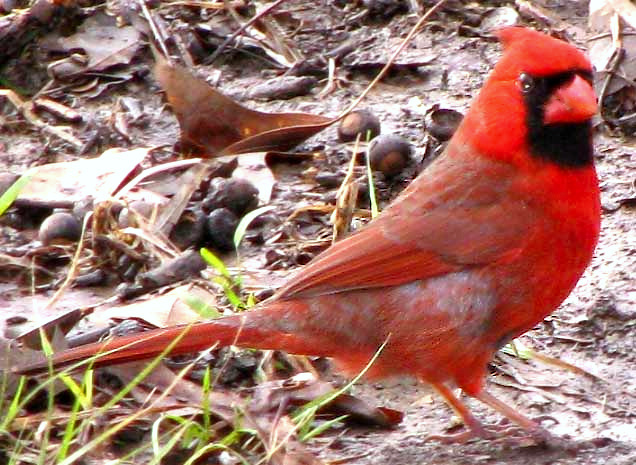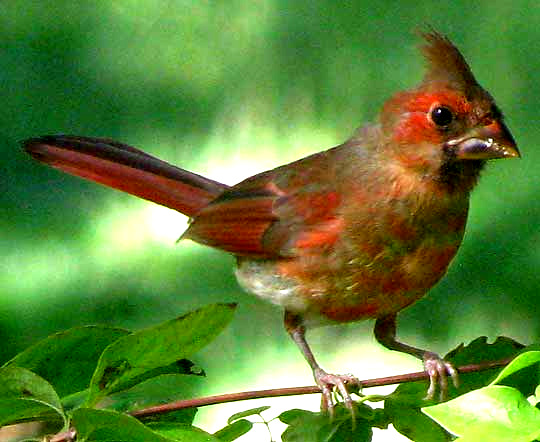Excerpts from Jim Conrad's
Naturalist Newsletter

from the April 20, 2003 Newsletter, issued from near Natchez, Mississippi:
COURTSHIP SHENANIGANS
The other day I focused my binoculars on a pair of Cardinals foraging at the edge of the lawn at the hunters' camp. The very instant the bright male found something in the grass and tilted forward to retrieve it, the female swooped to beside him, squatted low, quivered her wings and gaped her beak wide open exactly as a nestling might. The male then fed her what he had found. This went on for several minutes, the male constantly dropping this and that into her gaping gullet.
Finally there came a moment when the begging female bumped up against him almost aggressively, but this time the male just sort of threw up his wings as if his nervous system had short-circuited and he unceremoniously flew away. The female must have had her eyes closed because she remained crouching, wing- quivering and gaping for a second or two before she shut her mouth, stood erect, looked around... and in her body language I could read volumes.
from the July 22, 2012 Newsletter, issued from the forest near Natchez, Mississippi; elevation ~400ft (120m), ~N31.47°, ~W91.29°:
CARDINAL TEENAGER
Nowadays often you see adult birds flying around with juveniles in tow. If the adult finds food the kids rush close begging piteously, gaping and quivering their wings. As days pass the young are supposed to take more responsibility for their own food-gathering but of course it's easier to be fed by parents, so if you watch these foraging families closely you witness many moments of awkwardness and tension -- as when an adult suddenly seems to fly off the handle and peck at a beggar instead of feed it; then you see the confusion of both parties, maybe even guilt. We're not supposed to anthropomorphize when watching the behavior of other animals, but nowadays it's hard to keep from it.

Above you see a juvenile male Cardinal whose blotchy plumage shows that he's at an age equivalent to that of a teenage human. The full glory of his future red-feathered maleness is only half developed, the black "beard" is little more than a fuzzy dinginess, and the cocky crest is only half formed. The behavior of such birds matches their looks. They explore spots the adults don't go to, yet they never range far beyond the family unit. You might see them flying so enthusiastically that upon landing they trip, or momentum carries them beyond their landing pad. They try to eat things the adults never would bother with.
But, it's a pleasure seeing these new birds, especially when you think of all the hazards around them, the habit destruction, the herbicides and pesticides people spray, even the unruly weather. Despite all that, here's a fresh new bird who looks intact and eager to get on with business in every way, a whole new generation coming of liquid, springtime callings of "chur birdy birdy birdy birdy birdy burr... "
from the October 13, 2002 Newsletter, issued from near Natchez, Mississippi:
CARDINAL ANTING OR APHIDING
While my breakfast baked over the campfire I vacantly eyed a male Cardinal on a limb inside the nearby Waxmyrtle tree. The bird seemed to know exactly where he wanted to go. When he got there he immediately bent over the branch's side, with his beak quickly picked something from the branch's bottom bark, opened one wing and appeared to smear in a single, jerky movement whatever he had removed from below the branch under his wing! I couldn't tell if he was rubbing the wing's inner surface or the tender part of his body usually covered by the wing. This whole process took only three or four seconds, then immediately he repeated the entire process, this time beneath the other wing. During a minute or so he alternated between wings maybe ten times.
When he left I went into the Waxmyrtle to look at the spot where he had been. I found a densely populated colony of perhaps a hundred giant aphids, some of them the size of BBs, others tiny. Had the Cardinal been preening beneath his wings with the juices of smashed aphids? Certainly these aphids were turgid with sweet sap sucked from the Waxmyrtle's limb, but I've never heard of birds smearing sugar-water over their feathers.
Later in the day I returned to the same spot. This time only half a dozen aphids were present, but now so were several very large, slow-moving ants of a kind I don't recall seeing here. Ants are known to move about colonies of aphids they milk for honeydew.
In bird literature there's a phenomenon known as "anting," where birds have been observed placing ants on their bodies for unknown purposes. A good guess is that formic acid from the ants' crushed bodies repel external parasites.
I'll bet that I'd witnessed the Cardinal "anting" with ants tending the aphid colony. I think I almost made a splendid observation, but I was unable to see the whole thing.
There's a page about bird anting (and smoking) at http://birds.ecoport.org/Behaviour/EBanting.htm.
from the April 14, 2007 Newsletter, issued from Jalpan, Querétaro, Mexico:
MEXICAN CARDINALS
Some mornings a Cardinal sings in a Sweet Acacia right outside my casita. The song is indistinguishable from how it sounds up north. The liquid CHEW-CHEW-CHEW-CHEW stirs up childhood memories of my mother in spring-green Kentucky grass hanging big white sheets on the clothesline, the sheets flapping and snapping in chilly, moist April wind as "Red Bird" calls from the Flowering Peach tree. And I remember what a sight a Cardinal was singing in a dark green, Mississippi magnolia. CHEW-CHEW-CHEW-CHEW and I look at the parched, wrinkled skin on my hands and arms and wonder how I got from there to here.
Cardinals down here are the very same species that are so common and eye-catching in Eastern North America's woods and suburbs, and the US Desert Southwest. The Northern Cardinal's distribution extends deep into Mexico all the way along the Gulf Coast to the Yucatan and northern Guatemala and Belize. It's an unusual distribution that must hint at something in the species' evolutionary history.